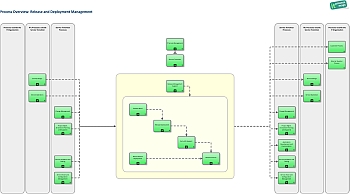Release and Deployment Management
| diese Seite auf Deutsch |
|---|
ITIL Version: ITIL Version 3 (ITIL V3)
Process Objective: To plan, schedule and control the movement of releases to test and live environments. The primary goal of Release and Deployment Management is to ensure that the integrity of the live environment is protected and that the correct components are released.
Part of: Service Transition
Process Owner: Release Manager
ITIL V3 vs. ITIL V2: Release and Deployment Management
- Essentially, the activities and process objectives of the Release and Deployment Management process in ITIL V3 are identical to Release Management in ITIL V2
- ITIL V3 provides considerably more details in the areas of Release planning and testing; this led to the addition of two dedicated processes in ITIL V3 which were subsumed under Release Management in the previous ITIL version:
- Project Management (Transition Planning and Support)
- Service Validation and Testing
Sub-Processes of Release and Deployment Management (ITIL V3)

- Release Management Support
- Process Objective: To provide guidelines and support for the deployment of Releases.
- Minor Release Deployment
- Process Objective: To deploy minor, low-risk Releases into the productive environment. This process is used as a streamlined way to deploy Releases which do not require full-scale project planning and quality assurance, as they are limited in size and their associated risk is low and well understood.
- Release Build
- Process Objective: To issue all necessary Work Orders and Purchase Requests so that Release Components are either bought from outside vendors or developed/ customized in-house.
- Release Deployment
- Process Objective: To deploy the Release components into the live production environment. This process is also responsible for training end-users and operating staff, as well as circulating information/ documentation on the newly deployed Release or the services it supports.
- Early Life Support
- Process Objective: To resolve operational issues quickly during an initial period after Release deployment, and to remove any remaining errors or deficiencies.
- Release Closure
- Process Objective: To formally close a Release after verifying if activity logs and CMS contents are up to date.
Related Key Performance Indicators
Roles within Release and Deployment Management (ITIL V3)
- Release Manager (Process Owner)






